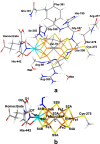Thermodynamically Favourable States in the Reaction of Nitrogenase without Dissociation of any Sulfide Ligand
- PMID: 35006641
- PMCID: PMC9305431
- DOI: 10.1002/chem.202103933
Thermodynamically Favourable States in the Reaction of Nitrogenase without Dissociation of any Sulfide Ligand
Abstract
We have used combined quantum mechanical and molecular mechanical (QM/MM) calculations to study the reaction mechanism of nitrogenase, assuming that none of the sulfide ligands dissociates. To avoid the problem that there is no consensus regarding the structure and protonation of the E4 state, we start from a state where N2 is bound to the cluster and is protonated to N2 H2 , after dissociation of H2 . We show that the reaction follows an alternating mechanism with HNNH (possibly protonated to HNNH2 ) and H2 NNH2 as intermediates and the two NH3 products dissociate at the E7 and E8 levels. For all intermediates, coordination to Fe6 is preferred, but for the E4 and E8 intermediates, binding to Fe2 is competitive. For the E4 , E5 and E7 intermediates we find that the substrate may abstract a proton from the hydroxy group of the homocitrate ligand of the FeMo cluster, thereby forming HNNH2 , H2 NNH2 and NH3 intermediates. This may explain why homocitrate is a mandatory component of nitrogenase. All steps in the suggested reaction mechanism are thermodynamically favourable compared to protonation of the nearby His-195 group and in all cases, protonation of the NE2 atom of the latter group is preferred.
Keywords: QM/MM; alternating mechanism; homocitrate; nitrogen fixation; nitrogenase.
© 2022 The Authors. Chemistry - A European Journal published by Wiley-VCH GmbH.
Conflict of interest statement
The authors declare no conflict of interest.
Figures








Similar articles
-
N2H2 binding to the nitrogenase FeMo cluster studied by QM/MM methods.J Biol Inorg Chem. 2020 May;25(3):521-540. doi: 10.1007/s00775-020-01780-5. Epub 2020 Apr 7. J Biol Inorg Chem. 2020. PMID: 32266560 Free PMC article.
-
Putative reaction mechanism of nitrogenase with a half-dissociated S2B ligand.Dalton Trans. 2024 Jul 9;53(27):11500-11513. doi: 10.1039/d4dt00937a. Dalton Trans. 2024. PMID: 38916132
-
Proton Transfer Pathways in Nitrogenase with and without Dissociated S2B.Angew Chem Int Ed Engl. 2022 Sep 26;61(39):e202208544. doi: 10.1002/anie.202208544. Epub 2022 Aug 19. Angew Chem Int Ed Engl. 2022. PMID: 35920055 Free PMC article.
-
Computational Investigations of the Chemical Mechanism of the Enzyme Nitrogenase.Chembiochem. 2020 Jun 15;21(12):1671-1709. doi: 10.1002/cbic.201900636. Epub 2020 Jan 21. Chembiochem. 2020. PMID: 31803989 Review.
-
Breaking the N2 triple bond: insights into the nitrogenase mechanism.Dalton Trans. 2006 May 21;(19):2277-84. doi: 10.1039/b517633f. Epub 2006 Apr 11. Dalton Trans. 2006. PMID: 16688314 Review.
Cited by
-
Understanding the Electronic Structure Basis for N2 Binding to FeMoco: A Systematic Quantum Mechanics/Molecular Mechanics Investigation.Inorg Chem. 2023 Apr 10;62(14):5357-5375. doi: 10.1021/acs.inorgchem.2c03967. Epub 2023 Mar 29. Inorg Chem. 2023. PMID: 36988551 Free PMC article.
-
13C ENDOR Characterization of the Central Carbon within the Nitrogenase Catalytic Cofactor Indicates That the CFe6 Core Is a Stabilizing "Heart of Steel".J Am Chem Soc. 2022 Oct 12;144(40):18315-18328. doi: 10.1021/jacs.2c06149. Epub 2022 Sep 27. J Am Chem Soc. 2022. PMID: 36166637 Free PMC article.
-
The HD Reaction of Nitrogenase: a Detailed Mechanism.Chemistry. 2023 Jan 18;29(4):e202202502. doi: 10.1002/chem.202202502. Epub 2022 Nov 29. Chemistry. 2023. PMID: 36274057 Free PMC article.
-
Quantum Mechanical Calculations of Redox Potentials of the Metal Clusters in Nitrogenase.Molecules. 2022 Dec 21;28(1):65. doi: 10.3390/molecules28010065. Molecules. 2022. PMID: 36615260 Free PMC article.
-
Biological nitrogen fixation in theory, practice, and reality: a perspective on the molybdenum nitrogenase system.FEBS Lett. 2023 Jan;597(1):45-58. doi: 10.1002/1873-3468.14534. Epub 2022 Nov 28. FEBS Lett. 2023. PMID: 36344435 Free PMC article. Review.
References
-
- Smith B. E., Science 2002, 297, 1654–1655. - PubMed
-
- Burgess B. K., Lowe D. J., Chem. Rev. 1996, 96, 2983–3012. - PubMed
-
- Schmid B., Chiu H.-J., Ramakrishnan V., Howard J. B., Rees D. C., in Handb. Met., John Wiley & Sons, Ltd, 2006, pp. 1025–1036.
-
- Kim J., Rees D. C., Science 1992, 257, 1677–1682. - PubMed
MeSH terms
Substances
Grants and funding
LinkOut - more resources
Full Text Sources

